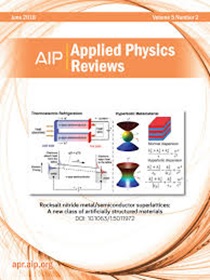所有二维范德华磁隧穿结
IF 11.6
1区 物理与天体物理
Q1 PHYSICS, APPLIED
引用次数: 0
摘要
磁隧道结(MTJs)在磁传感器、磁随机存储器、自旋逻辑门等领域具有重要的应用潜力。然而,传统的由磁性薄膜组成的MTJ器件通常存在界面缺陷和低缩放,严重影响器件性能。相比之下,所有二维(2D)范德华(vdW) MTJs都提供了有效的解决方案来避免这些问题,因为它们具有原子平坦的表面,抑制了界面混合,并且低维。在这篇综述中,我们系统地概述了全2d vdW MTJs的最新进展,包括自旋阀和自旋过滤器配置。根据二维磁性材料的类型对所讨论的系统进行了分类。然后,介绍了调制MTJs性能的有效策略,如调节偏置电压/电流、隧道层厚度和自旋角。最后,讨论了全二维MTJs未来发展面临的挑战和前景,强调了该领域实现突破的潜力。本文章由计算机程序翻译,如有差异,请以英文原文为准。
All two-dimensional van der Waals magnetic tunneling junctions
Magnetic tunnel junctions (MTJs) have exhibited significant application potential in magnetic sensors, magnetic random-access memory, spin-based logic gates, etc. However, conventional MTJ devices consisting of magnetic thin films usually suffer from interface defects and low scaling, severely compromising device performance. In contrast, all two-dimensional (2D) van der Waals (vdW) MTJs offer an effective solution to avoid these problems, due to their atomically flat surfaces, suppressed interfacial mixing, and low dimensionality. In this review, we provide a systematic overview of recent advancements in all-2D vdW MTJs involving both spin-valve and spin-filter configurations. The discussed systems are classified according to the types of 2D magnetic materials. Then, the effective strategies for modulating the performance of MTJs are introduced, such as regulating the bias voltage/current, the thickness of the tunneling layer, and spin angles. Finally, the challenges and prospects for the future development of all-2D MTJs are discussed, highlighting the potential for realizing breakthroughs in this field.
求助全文
通过发布文献求助,成功后即可免费获取论文全文。
去求助
来源期刊

Applied physics reviews
PHYSICS, APPLIED-
CiteScore
22.50
自引率
2.00%
发文量
113
审稿时长
2 months
期刊介绍:
Applied Physics Reviews (APR) is a journal featuring articles on critical topics in experimental or theoretical research in applied physics and applications of physics to other scientific and engineering branches. The publication includes two main types of articles:
Original Research: These articles report on high-quality, novel research studies that are of significant interest to the applied physics community.
Reviews: Review articles in APR can either be authoritative and comprehensive assessments of established areas of applied physics or short, timely reviews of recent advances in established fields or emerging areas of applied physics.
 求助内容:
求助内容: 应助结果提醒方式:
应助结果提醒方式:


